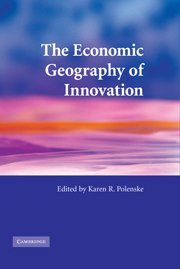Book contents
- Frontmatter
- Contents
- List of figures
- List of tables
- Notes on contributors
- Acknowledgments
- Abstracts
- List of abbreviations and acronyms
- Part I Concepts and measurements in innovation
- Part II Institutional and spatial aspects of information and knowledge flows
- 5 Tacit knowledge in production systems: how important is geography?
- 6 The self-aware firm: information needs, acquisition strategies, and utilization prospects
- 7 Theorizing the gendered institutional bases of innovative regional economies
- 8 Multinationals and transnational social space for learning: knowledge creation and transfer through global R&D networks
- 9 Brain circulation and regional innovation: the Silicon Valley–Hsinchu–Shanghai triangle
- Part III Institutions and innovation systems
- Index
- References
8 - Multinationals and transnational social space for learning: knowledge creation and transfer through global R&D networks
Published online by Cambridge University Press: 22 September 2009
- Frontmatter
- Contents
- List of figures
- List of tables
- Notes on contributors
- Acknowledgments
- Abstracts
- List of abbreviations and acronyms
- Part I Concepts and measurements in innovation
- Part II Institutional and spatial aspects of information and knowledge flows
- 5 Tacit knowledge in production systems: how important is geography?
- 6 The self-aware firm: information needs, acquisition strategies, and utilization prospects
- 7 Theorizing the gendered institutional bases of innovative regional economies
- 8 Multinationals and transnational social space for learning: knowledge creation and transfer through global R&D networks
- 9 Brain circulation and regional innovation: the Silicon Valley–Hsinchu–Shanghai triangle
- Part III Institutions and innovation systems
- Index
- References
Summary
Introduction
Multinational enterprises (MNEs) are unique knowledge-creating organisations because of their superior ability to engage in knowledge transfer across national borders within the context of interorganisational networks (Kogut and Zander 1993; Gupta and Govindarajan 2000). The ways in which MNEs develop their transnational social space for learning, however, differ significantly between firms on the basis of the dominant organizational model and patterns of learning derived from the home contexts. In this chapter, I build on the institutional perspective, which stresses the strong influence of home-based institutions on the structure and behavior of MNEs (Pauly and Reich 1997; Doremus et al. 1998; Whitley 1999, 2001; Morgan 2001). I examine the ways in which national patterns of organization and innovation affect firms' global R&D networks and transnational learning activities. One notable recent trend in the management of innovation within MNEs has been the extension of R&D activities and competence portfolios on a global scale (Gerybadze and Reger 1999; Pearce 1999) to augment the knowledge base of the firm (Howells 1990; Florida 1997; Kuemmerle 1997, 1999a, 1999b). In the science-based high-technology industries in particular, a growing element of firms' strategies involves collaboration with world-class academic institutions and research centers, and recruitment of the best scientific personnel on a global scale (Kaounides 1999). Accordingly, I examine the organizational and human resource strategies adopted by US and Japanese MNEs in managing their global R&D networks and transnational learning in the pharmaceutical and ICT sectors.
- Type
- Chapter
- Information
- The Economic Geography of Innovation , pp. 157 - 189Publisher: Cambridge University PressPrint publication year: 2007
References
- 8
- Cited by



